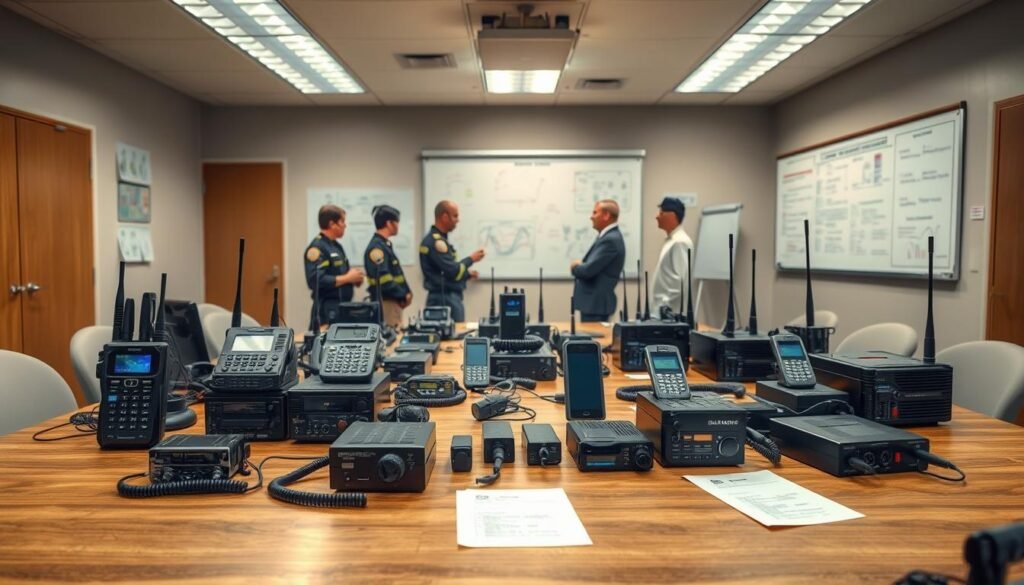Essential Communication Devices, Apps, and Protocols for Emergencies
Nearly 80% of organizations report faster incident containment after adding mass alerts. That level of impact shows why you must plan how your team shares time-sensitive facts when normal channels fail.
You will learn how to pick and combine tools so you can send urgent information to the right people without adding clutter.
Two-way channels let recipients ask for help and share status, which speeds response and keeps everyone safer.
Standard message templates, clear roles, and approval flows stop rumors and keep updates accurate. You’ll also build redundancy across SMS, voice, email, radio, social media, and satellite so a single failure won’t break your system.
Take planning seriously. Bookmark this guide and return often for the latest survival methods and practical updates you can apply today.
Key Takeaways
- Choose layered communication systems so critical information reaches people fast.
- Use two-way channels to gather field reports and speed response.
- Standardize messages and roles to avoid confusion during incidents.
- Build redundancy across multiple paths to prevent single points of failure.
- Adopt templates and approval steps to keep updates accurate and actionable.
- Check this guide regularly for updated practices and real-world tips.
Why Emergency Communication Matters Right Now
When seconds count, clear and fast alerts save lives and protect assets. Rapid communication reduces confusion and helps you direct people to safety during an emergency.
Effective systems push critical information fast with simple, clear concise instructions that guide action. They also keep operations running when primary channels fail.
You should use multiple channels so messages reach individuals across text, voice, email, and apps. Redundancy raises delivery odds when networks are congested or down.
- Two-way alerts let people request help, confirm status, and speed resource allocation.
- Standard templates and best practices remove ambiguity and cut decision time.
- Plan for different language needs and accessibility so vital instructions are understood the first time.
Treat a communication system as a core business capability. Schedule regular training so your team knows procedures before a crisis, not during it. That preparedness improves response and outcomes across your workforce and nearby communities.
Plan Your Emergency Communication the Right Way
Begin with measurable targets that tell you who to alert, when to alert them, and what they must do.
Set clear objectives so your communication system maps to real risks. Define who must receive alerts, the target delivery time, and the required actions. Keep each goal short and measurable.
Set objectives, roles, and contact trees before an incident
Assign owners for drafting, approval, and distribution. Establish contact trees by function and location with primary and alternate approvers.
Build redundancy across channels and power sources
Use multiple paths—SMS, voice, email, two-way radio, social platforms, and satellite. Add backup power to keep methods alive during outages.
Create an update rhythm for evolving situations
Prewrite action templates with plain language, timestamps, and next steps. Set a cadence (for example, every 15–30 minutes) so teams expect regular updates.
Bookmark this continually updated guide
Run drills, refine your protocols, and schedule training to validate assumptions. Bookmark this guide to keep current with evolving practices and legal considerations.
| Objective | Owner | Cadence |
|---|---|---|
| Reach on-site staff in 5 min | Site Safety Lead | Immediate alert + 15 min update |
| Notify remote teams in 10 min | Ops Manager | Immediate alert + 30 min update |
| Public notice and rumor control | PR Lead | Every 30 min until cleared |
Choosing the Right Communication Channels
Choose channels that match the audience, environment, and likely failure modes so messages land when they matter.
Speed, reach, and reliability should drive your selections. Combine SMS, voice calls, and email to cover different delivery behaviors and device access.
SMS, voice calls, and email
Use text for rapid alerts and short instructions. Follow with voice when confirmation or detailed guidance is needed.
Email works well for longer updates and files, but expect slower action during fast-moving incidents.
Two-way radios and radio protocols
Deploy two-way radios with standardized identifiers and concise call signs. Clear radio rules cut errors in noisy or congested sites.
Social platforms and rumor control
Post verified public updates and actively monitor comments. Use social channels to correct misinformation and answer common questions.
Satellite and analog backups
Provision satellite phones and manual methods so your critical lines survive cellular or internet outages. Treat these as tested fallbacks.
Accessibility and language
Support multiple languages, screen-reader formats, and relay services. Make two-way options—reply-by-text, hotlines, or app check-ins—available so recipients can report status and request help.
- Evaluate channels by speed, delivery reliability, and reach.
- Document primary and fallback mapping for common situations.
- Set channel-specific escalation rules to preserve speed when systems are overloaded.
Devices and Apps You Can Rely On During Emergencies
Pick tools that keep location, status, and alerts working when time matters most.
Mass notification systems push texts, email, voice, and mobile app alerts at once and can support two-way replies. These platforms help you provide immediate multi-channel notices and confirm delivery when networks are strained.
Mass notification platforms
Use a system that can target by role or geofence and record acknowledgments. That gives you quick situational awareness and improves response speed.
Emergency apps with two-way and location
Choose apps that let users report status, request help, and share GPS. A dedicated emergency alert app reduces confusion and speeds coordination when every minute counts.
IoT sensors, beacons, and triggers
Connect occupancy sensors and environmental beacons so thresholds auto-trigger alerts. This removes manual delay and sends real-time information to responders.
Rugged gear and headsets
Standardize on ruggedized handsets and noise-canceling headsets. They keep voices clear around sirens, heavy machinery, or bad weather so instructions reach field teams intact.
“Layered tools and tested workflows turn technology into reliable action during critical situations.”
- Test geofencing, offline caching, and priority notifications.
- Define maintenance cycles for batteries and firmware.
- Document which device handles each scenario so teams know what to use.
Essential Communication for Emergencies: Devices, Apps, and Protocols
When roles and message formats are fixed, teams act faster and with less error. You must standardize templates so every alert includes who, what, where, when, and required actions.
Standardize message formats to reduce confusion and speed response
Adopt simple templates with fields for sender, location, risk, and next steps. Use timestamps and expected reply actions to track progress.
Define roles, responsibilities, and approval processes
Assign owners to draft, approve, and release messages. Clear approval chains stop conflicting instructions and save time.
Use plain language and avoid jargon for clear, concise instructions
Write short sentences and single-step commands when possible. Favor plain language so people across roles and languages act quickly.
Ethical guardrails: privacy, consent, and secure channels
Limit shared personal data to what is necessary. Seek consent before transmitting health details and use encrypted channels for sensitive information.
“Standard templates, named approvers, and privacy rules make systems reliable and trusted.”
| Focus | Action | Outcome |
|---|---|---|
| Message format | Template: who/what/where/when/actions | Faster, consistent responses |
| Approval process | Named drafter, approver, sender | No conflicting alerts |
| Privacy | Minimize data, use encryption, obtain consent | Protected personal information |
| Continuous improvement | Drills, AARs, update library | Ongoing process improvement |
- Maintain a protocol library with escalation and fallback paths.
- Include acknowledgment and follow-up fields in each template.
- Bookmark this living guide and return often for the latest best practices.
Train, Test, and Improve Your Communication System
Frequent drills turn plans into instinctive actions under pressure.
You should schedule regular training so your team knows system features and roles before an incident. Short, focused sessions work best; they build familiarity without overwhelming staff.

Regular training cadence to build familiarity and confidence
Set a training calendar with monthly refreshers and annual recertification. Include new hires in onboarding sessions so everyone stays aligned.
Scenario-based drills to test channels and protocols
Run varied scenarios—severe weather, evacuation, medical, and security—to stress-test delivery, timing, and comprehension across channels.
After-action reviews to capture feedback and areas for improvement
Conduct structured after-action reviews to collect feedback and identify areas improvement. Assign owners and deadlines for corrective actions and verify fixes in follow-up tests.
“Simulations reveal weak links quickly; fix them, then test again.”
- Measure delivery rates, acknowledgments, and response times during exercises.
- Assign a drill controller and a communications lead to mirror real command flow.
- Document findings, owners, and verification dates so issues do not recur.
| Practice | Goal | Metric |
|---|---|---|
| Monthly training | Feature familiarity | Attendance rate, quiz score |
| Scenario drills | Channel reliability | Delivery %, ack rate |
| After-action review | Continuous improvement | Corrective actions closed |
Field-Proven Practices from Emergency Responders
Frontline crews use short, structured check-ins to keep teams focused on immediate tasks.
Briefings, updates, and debriefings to keep teams aligned
You will run concise briefings at the start and routine updates during emergency situations. These quick talks set objectives, risks, and resource needs so actions are clear.
After an incident, debriefs capture lessons and sharpen future response.
Structured handovers using SBAR
Use SBAR—Situation, Background, Assessment, Recommendation—so handovers carry only vital facts. This format reduces confusion and shortens transfer time between teams.
Overcoming noise, chaos, and language barriers
Standardized call signs, acknowledgment rules, and a single team leader cut through chaotic scenes. Equip crews with noise-canceling headsets and rugged devices to provide immediate clarity on critical instructions.
Address language gaps with interpreters, language lines, or translation apps. Speak plainly and slowly to improve understanding in multi-language scenarios.
Compassionate talk with patients and families
Speak with empathy. Honest, calm updates ease anxiety and improve cooperation. Share only necessary details and move sensitive exchanges to secure, private settings.
“Brief, structured habits and respectful speech protect people, speed response, and improve outcomes.”
- Run short briefings and timed updates during incidents.
- Use SBAR for handovers to avoid confusion.
- Standardize radios, names, and acknowledgments across levels.
- Equip teams with headsets and tested devices to keep messages intelligible.
Maintain Readiness with Updates and Continuous Improvement
Keep your system sharp by tracking key metrics and acting on what the data shows. Regular measurement turns plans into dependable action and helps you spot weak links fast.
Monitor response times, delivery rates, and communication outcomes
Track send success, open and acknowledgment rates, and time to action. These metrics show whether messages arrive and prompt the correct response.
Use dashboards and simple reports so owners can spot delays and fix them quickly. Turn metrics into tasks with deadlines and named owners.
Update contact databases, templates, and technologies over time
Audit contact lists often and enable automated syncs to keep records current. Refresh templates after drills or incidents so information stays accurate and concise.
Plan technology refresh cycles for mass notification, apps, and IoT sensors so your systems match evolving risks and capabilities.
Regularly revisit best practices as conditions, tools, and risks evolve
Run after-action reviews and collect feedback after real events and exercises. Convert findings into process updates and assign owners to close gaps.
Schedule quarterly reviews and routine training so every level stays ready. Bookmark this blog and return often for the latest updates and survival information.
“Measure, fix, train: repeat this cycle to keep response times low and outcomes high.”
| Metric | Action | Owner |
|---|---|---|
| Send success / delivery % | Investigate failures; switch channels as needed | Ops Manager |
| Acknowledgment / open rate | Adjust templates; retrain recipients | Comms Lead |
| Time to action (minutes) | Run targeted drills; refine escalation | Site Safety Lead |
| Contact accuracy | Automated syncs; quarterly audits | HR / IT |
Conclusion
Clear roles and tested flows make urgent updates reliable under pressure.
Proper planning ties people, processes, and tools into a single plan that can provide immediate, clear instructions during an emergency. Use standardized message templates, multi-channel delivery, and two-way checks so individuals know what actions to take and when.
Keep privacy and consent rules in place while you test mass notification, apps, and IoT links. Run drills, use SBAR handovers, and track response times and delivery metrics to improve outcomes over time.
Take planning seriously. Bookmark this continually updated guide and return with questions as you refine your communication system and protect your people and community.
FAQ
What devices and apps should you prioritize before an incident?
Prioritize reliable mass-notification services (like Everbridge or AlertMedia), two-way radio systems (such as Motorola Solutions), and emergency apps that provide location and status updates. Include rugged phones, power banks, and noise-canceling headsets. Build redundancy with satellite or analog backups for when cellular networks fail.
How do you set up clear roles and contact trees?
Define decision-makers, message approvers, and field contacts in writing. Create a primary and secondary contact tree with multiple ways to reach each person. Test those contacts regularly and store them in both digital and printed formats to avoid single points of failure.
What messaging format improves speed and reduces confusion?
Use short, standardized templates that include the incident type, location, immediate action, and a single reliable source for updates. Avoid jargon, use plain language, and include timestamps. Consistent templates speed approval and make messages easier to follow under stress.
How often should you send updates during a fast-moving event?
Establish a predictable update rhythm—initial alert, status update at set intervals (e.g., every 15–30 minutes for critical events), and a clear “all clear” message when the situation stabilizes. Tailor frequency to event severity and audience needs to avoid alert fatigue.
What accessibility and language considerations should you plan for?
Provide messages in the primary languages of your audience and use plain language. Offer text-to-speech options, large-font printed notices, and visual cues for those with hearing or sight impairments. Include alternate contacts for people with special needs.
How can you maintain communications if the network goes down?
Use two-way radios, satellite phones, and mesh-networking tools. Deploy preconfigured analog fallback plans and designated meeting points. Ensure key personnel carry backup power sources and offline contact lists.
What training schedule keeps teams ready without overburdening staff?
Run short, focused drills monthly and full-scale exercises quarterly or biannually. Rotate scenarios and roles to build familiarity. Keep sessions under an hour when possible and pair drills with quick after-action reviews for fast learning.
How do you evaluate which channels are most effective after an event?
Track delivery rates, open/read metrics, response times, and qualitative feedback. Compare which channels reached intended audiences fastest and where gaps occurred. Use after-action reports to update contact lists, templates, and channel priorities.
What privacy and ethical safeguards should guide emergency messages?
Limit personally identifiable information in broadcasts, use encrypted channels for sensitive exchanges, and obtain consent where practical. Define retention policies for communication logs and ensure compliance with HIPAA or other relevant regulations.
How do you handle public updates and control rumors on social media?
Post timely, factual updates from verified official accounts. Assign a social media lead to monitor and respond to misinformation quickly. Link to an authoritative status page and use consistent wording to build trust and reduce panic.
What features should you look for in an emergency communication platform?
Look for multi-channel delivery (SMS, voice, email, push), two-way messaging, automated escalation, real-time reporting, location services, and strong security. Ensure the vendor offers 24/7 support and proven uptime metrics.
How do you keep templates and contact databases up to date?
Schedule regular audits—quarterly for high-turnover roles and annually for wider databases. Automate data syncs with HR systems when possible, and require team members to confirm their details after each drill or training exercise.
What are quick steps you can take today to improve your emergency messaging?
Create a single concise alert template, list two backup contacts for critical roles, test one alternative channel (radio or satellite), and run a 15-minute tabletop drill. These actions improve clarity, redundancy, and response speed immediately.


